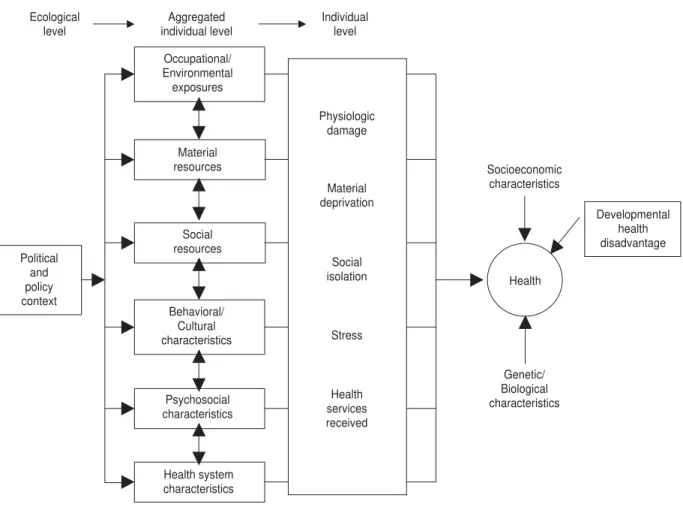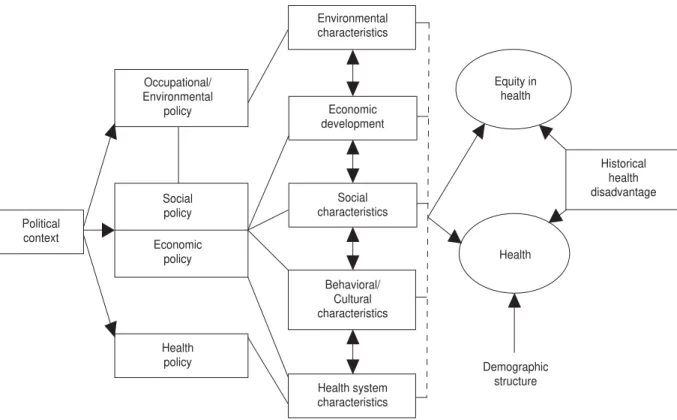384 Rev Panam Salud Publica/Pan Am J Public Health12(6), 2002
Equity and health: a perspective on
nonrandom distribution of health
in the population
Barbara Starfield
1The nonrandom distribution of ill health across and within populations is cause for ethical con-cern. Systematic differences in health across populations and subpopulations are a result of teractions among many types of influences operating on broad ecological, community, and in-dividual levels. The operation of this web of influences potentiates health disadvantage for some populations and subpopulations and, conversely, enhances resilience to health threats in more advantaged populations. Understanding the genesis of inequity requires an appreciation of the dynamics of these interactions. Thus, research directed at elucidating the causes of inequity in order to facilitate policy changes requires the adoption of conceptual frameworks to guide more efficient and effective future scientific inquiry concerning this worldwide imperative.
Health status, health inequalities, equity, socioeconomic factors, health services research.
ABSTRACT
Inequalities in health do not occur randomly. Rather, health problems cluster systematically in the popula-tion: some people and some groups within the population experience more than their ìfairî share of ill health, and some have less. With the exception of some survey data, this systematic variability is masked in virtually all existing information on the health of populations. The aver-age health statistics that characterize health at the national, state, regional, or local level convey no information about the extent of clustering of health
problems and compromises to health; as represented by most vital statistics, average figures hide wide variations within the population.
Although the burden of illness, as conventionally assessed, increases with age, clustering is not primarily an age effect, nor are differences in clustering in different populations a result of dif-fering age distributions. (The well-accepted notion of increased illness with aging is the main reason for stan-dardization of mortality rates within and across health services systems.) In fact, the nonrandomness of illness dis-tributions is greater in younger age groups than in older ones (1).
Geneticists have long known that the mere presence of a faulty gene sel-dom causes disease, even when the
gene is ìdominant.î Studies deriving from the ancient science of animal hus-bandry provided abundant evidence that disease causation is often multi-factorial and very complex (2). Terms were coined to describe this variability in vulnerability to illness and, con-versely, in resilience to illness in the face of a risk factor. ìPenetranceî is the term for conveying the notion that the mere presence of a gene normally associated with the occurrence of a disease does not always cause the disease. ìPleiotropismî indicates the capacity of a gene to simultaneously influence multiple characteristics as-sociated with abnormality (3). Con-versely, ìetiologic heterogeneityî de-scribes situations in which a disease appears to be associated with a variety
1 The Johns Hopkins Bloomberg School of Public
Health, Baltimore, Maryland 21205, United States of America. Send correspondence to: bstarfie@ jhsph.edu.
Rev Panam Salud Publica/Pan Am J Public Health12(6), 2002 385 of genetic abnormalities (4). The great
complexity in the web of disease cau-sation linked to genetic mechanisms holds equally true for diseases for which there is no known genetic pre-disposition, and being aware of this complexity provides the basis for un-derstanding why diseases and ill health are not distributed randomly in the population.
Figures 1 and 2 illustrate the com-plex web of causality of illness and risk states and why ill health and its mani-festations cluster systematically in populations. Figure 1 represents, albeit in simplified form, the variety of in-fluences on the health of individuals. The ìpathwayî is represented by envi-ronmental exposures, material circum-stances, personal behaviors and cul-tural practices, social networks and resources, beliefs and attitudes, and
exposures to various types of health services. Not shown in the diagram is the way in which these act internally on physiologic and neuroendocrine pathways (5). Therefore, the influences in the middle of the diagram show characteristics at the individual level, those just to the left of them represent characteristics of the individual that are aggregated at the community level and thus show ecological influences, and those at the extreme left of the diagram show ecological influences that characterize the context apart from the individuals within it.
Figure 2 is a similar diagram but is more relevant to understanding the level of population health as well as the distribution of health within popu-lations. This diagram places more emphasis on influences that operate at the contextual level, while recognizing
that the pathway ultimately causes changes at the individual level.
The interacting linkages across the categories and types of influences pro-vide the basis for understanding the clustering of ill health. That is, vulner-ability to one type of influence results in, or at least is associated with, nerability to others. The impact of vul-nerability is thus compounded such that certain individuals or population groups are vulnerable to a multiplicity of insults to health. Conversely, re-silience in one category of influences predisposes to resilience in others such that less vulnerable individuals and populations are more resilient to a wide variety of effects on health.
Both diagrams reflect the extraordi-nary complexity of the challenge of understanding the genesis of health inequities. From a policy vantage, the
FIGURE 1. Factors that influence health at the individual level
Ecological level
Aggregated individual level
Individual level
Political and policy context
Occupational/ Environmental exposures
Material resources
Social resources
Behavioral/ Cultural characteristics
Psychosocial characteristics
Health system characteristics
Physiologic damage
Material deprivation
Social isolation
Stress
Health services received
Health
Developmental health disadvantage
386 Starfield ï Equity and health: a perspective on nonrandom distribution of health in the population immediate focus should be on finding
the most feasible ìattack point.î That is, while a long-term strategy should be to elucidate and eliminate all causes of health inequities, both distal and proximal, the immediate imperative is to find links in the cross-chains that are remediable through the concerted effort of countries and international organizations. One promising ap-proach is to examine changes in the ex-tent and types of inequity in health that can be linked to policy changes (6). Policy changes can then be imple-mented on a trial basis and examined for their impact.
Inequity results from systematic and a potentially remediable disad-vantage in one or more aspects of health across socially, demographi-cally, or geographically defined popu-lations or population subgroups. Un-derstanding the genesis of inequity requires an appreciation of the
dy-namics of interactions within the web of causality as represented by the two figures. It is very unlikely that this web operates in the same way in all countries, in all regions of a country, in different population groups within a country, in different cohorts of peo-ple, or for different measures of health. Studies of these pathways have become increasingly common over the past five years, but the re-search literature still lacks the com-mon framework that will be necessary to translate this information into effec-tive action for understanding and for change. An agenda that organizes the new information into coherent pat-terns is essential for making the infor-mation useful in any concerted at-tempt to eliminate inequities in health through policy reforms (7).
The very large variety of characteris-tics that need to be considered is daunting (8), and this poses an
enor-mous challenge to policy-related re-search and evaluation efforts. It seems clear that collaborations within and across countries on such investigations are mandatory if there is to be timely applicability of findings around the world. A new organization working in that direction is the International Society for Equity in Health (ISEqH), whose aim is to encourage and cat-alyze research efforts so that they can be optimally useful in making the case for changes toward attaining equity within and among countries. Those in-terested in contributing toward this goal are encouraged to become mem-bers of the group and to participate in its activities. Information on ISEqH and its conferences and other activi-ties is available from the groupís Web site, at http://www.iseqh.org. An elec-tronic journal has also been launched; information about it can be found at: http://www.equityhealthj.com. FIGURE 2. Factors that influence health at the population level
Occupational/ Environmental
policy
Social policy Economic
policy
Health policy
Environmental characteristics
Economic development
Social characteristics
Behavioral/ Cultural characteristics
Health system characteristics
Equity in health
Health
Demographic structure
Historical health disadvantage Political
context
Rev Panam Salud Publica/Pan Am J Public Health12(6), 2002 387
La distribución no aleatoria de los problemas de salud en una población y entre
difer-entes poblaciones es un problema ético. Las diferencias sistemáticas en la salud de
diferentes poblaciones y subpoblaciones son el resultado de interacciones entre mu-chos tipos de influencias que actan en los ámbitos ecológico, comunitario e
individ-ual. La actuación de esta red de influencias potencia las desventajas de salud de
algunas poblaciones y subpoblaciones, al mismo tiempo que incrementa la resistencia a las amenazas para la salud en las poblaciones mejor situadas. Para comprender la g énesis de la inequidad es necesario tener en cuenta la dinámica de estas
interac-ciones. Así pues, las investigaciones destinadas a elucidar las causas de la inequidad
con el fin de facilitar la modificación de las polˇticas requieren la adopción de marcos
conceptuales que dirijan de forma más eficaz y eficiente las investigaciones cientí ficas
futuras relacionadas con este imperativo mundial.
RESUMEN
Equidad y salud:
una perspectiva
sobre la distribución no
aleatoria de la salud
en la población
1. Van den Akker M, Buntinx F, Metsemakers JF, Roos S, Knottnerus JA. Multimorbidity in gen-eral practice: prevalence, incidence, and deter-minants of co-occurring chronic and recurrent diseases. J Clin Epidemiol 1998;51:367ñ375. 2. Mayr E. The growth of biological thought:di-versity, evolution, and inheritance. Cambridge, Massachusetts: Harvard University Press; 1982.
3. Cavalli-Sforza L, Bodmer W. The genetics of human populations. San Francisco: W.H. Free-man; 1971.
4. Holtzman N. Proceed with caution: predicting genetic risks in the recombinant DNA era.
Bal-timore, Maryland: Johns Hopkins University Press; 1989.
5. McEwen B, Seeman T. Protective and damag-ing effects of mediators of stress: elaboratdamag-ing and testing the concepts of allostasis and allo-static load. In: Adler N, Marmot M, McEwen B, Stewart J, eds. Socioeconomic status and health in industrialized nations: social, psychological, and biological pathways. New York: The New York Academy of Sciences; 1999.
6. Turrell G, Mathers C. Socioeconomic inequali-ties in all-cause and specific-cause mortality in Australia: 1985ñ1987 and 1995ñ1997. Int J Epi-demiol 2001;30:231ñ239.
7. Starfield B. Improving equity in health: a re-search agenda. Int J Health Serv 2001;31(3): 545ñ566.
8. Blane D. Commentary: socioeconomic health differentials. Int J Epidemiol 2001;30: 292ñ293.
Manuscript received 8 February 2002. Accepted for pub-lication 23 May 2002.
REFERENCES
International Health Economics Association World Congress
Dates: 15 18 June 2003
Location: Hilton San Francisco Hotel San Francisco, California United States of America
The theme of the 4th World Congress of the International Health Economics Association (IHEA) is Global Health Economics: Bridging Research and Reforms. The conference will open with a reception for all participants on Sunday, 15 June 2003, followed by three days of scientific papers. Preconference and postconference sessions are also planned, including workshops on research and methodological issues.
Among the themes of the 2003 conference are: global health economics, the emerging role of health consumers in the global health market, development and impact of biotechnology, poverty and health, economics of health disparities, reform of insurance and finance mechanisms, economics of infectious disease, economics of heart disease and cancer, and aging and health economics.
The fee to register for the conference is US$ 585 for IHEA members and US$ 660 for nonmembers, if paid by 31 March 2003. From 1 April to 31 May, the respective fees are US$ 685 and US$ 760; after 31 May, they are US$ 800 and US$ 875.
Information: Bill Swan, Associate Director International Health Economics Association Queen s University, Abramsky Hall, 3rd Floor
Kingston, Ontario K7L 3N6, Canada Telephone: 613-533-6675 Fax: 613-533-6353
E-mail: swanb@post.queensu.ca

